Supply and Exhaust Ventilation in a Surprising Place
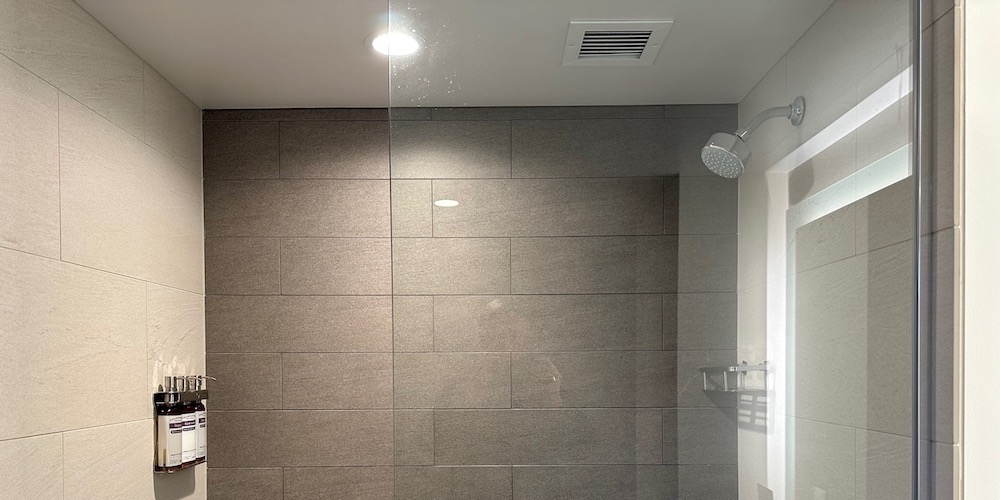
For the past couple of years, I’ve carried my Aranet4 carbon dioxide monitor* with me when I travel. For much longer than that, I’ve been checking the ventilation in hotel rooms. What I’ve found is that it’s rare to see a hotel room ventilated properly. Most hotel rooms have exhaust ventilation in the bathroom. I’ve never seen a hotel room with supply and exhaust ventilation. Last week, though, I got lucky. I stayed at the Hyatt Regency in Seattle while attending the always excellent National Home Performance Conference.
The toilet paper test
After a visual inspection of the exhaust vent in my hotel room, I almost always do the toilet paper test. I tear off one sheet of toilet paper and see how well it sticks to the exhaust vent. If it falls off, the vent is doing little to remove stale air from the room. If it gets shredded and sucked into the vent, well, that’s a bit too much exhaust.
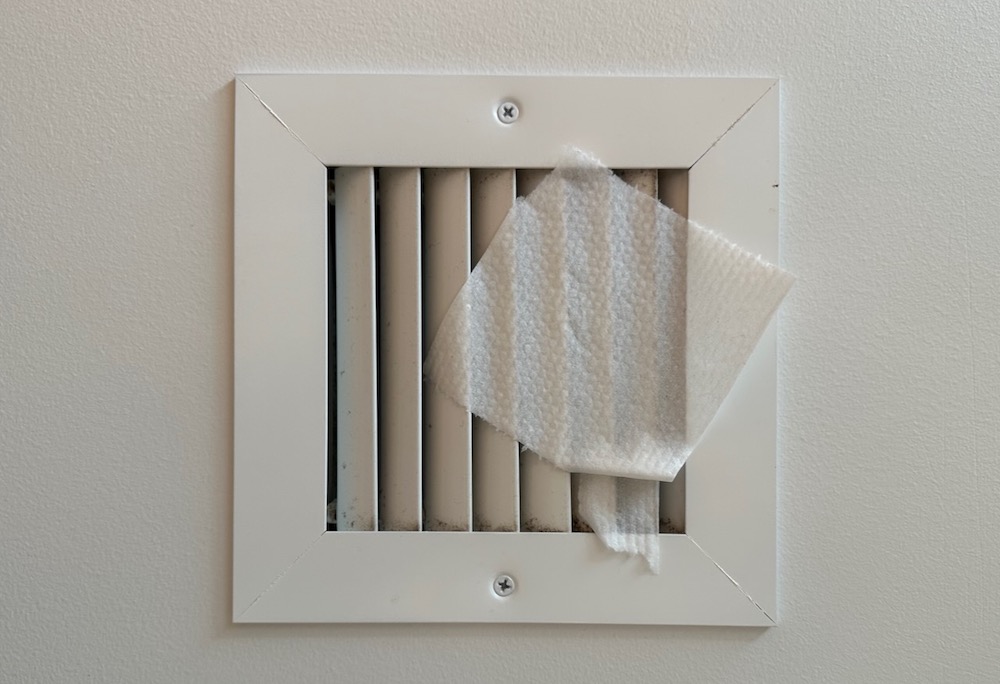
In my Hyatt Regency room, the toilet paper stuck with what seemed like an adequate amount of force. Hotels never buy the expensive calibrated toilet paper, so there’s some guesswork here.
A cubic foot out…
Now, if the exhaust vent is pulling air out of the room, that means air is coming in somewhere to make up for the lost air. A cubic foot of air going out will be replaced by a cubic foot of air coming in. (In metric world, that’s 35.3 cubic feet out and 1 cubic meter in.) So where was my makeup air coming from?
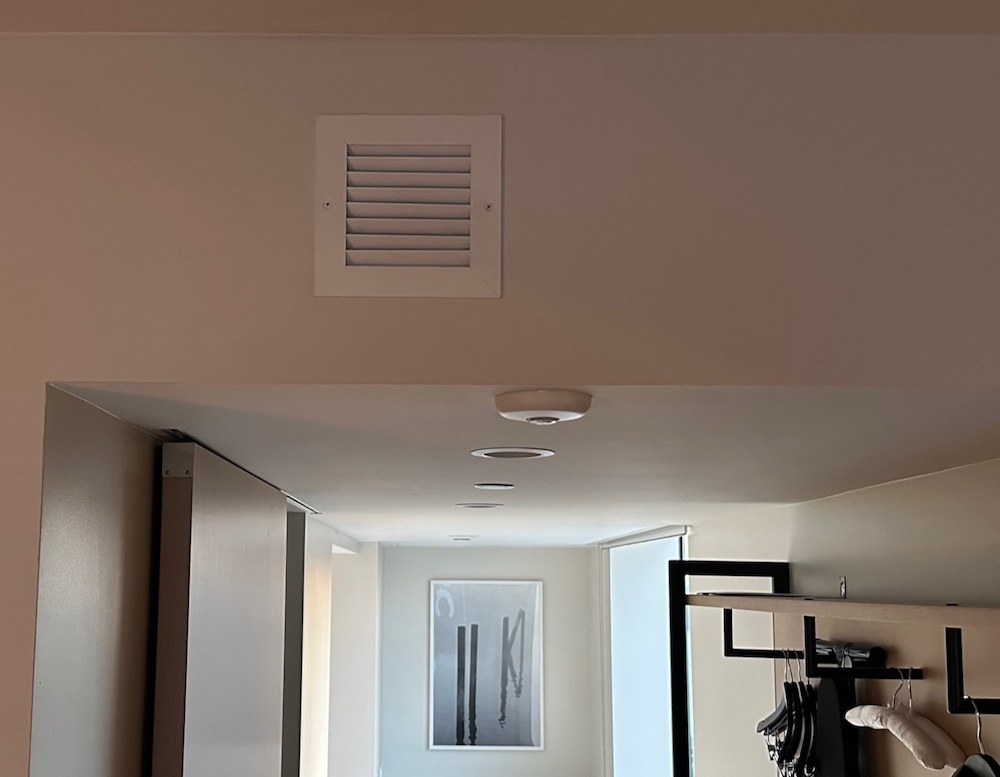
I first felt around the door. A little bit was coming in at some places but not nearly enough to replace what the bathroom exhaust was pulling out. Then I looked in the main room and saw the little vent in the photo above. At first I thought it was the supply for the heating and cooling system.
But it wasn’t. That little vent was the same size as the grille in the bathroom and seemed to be blowing about as hard as the other one was sucking. Actually, it must have been blowing a little less hard because I know some air was coming in around the door, too. It was great to see a supply and exhaust ventilation system in my room.
Carbon dioxide level
My carbon dioxide (CO2) monitor showed the same story. In the graph below, the range of CO2 was from ~500 to ~900 parts per million (ppm). A peak of 900 ppm is amazingly low for a hotel room. An average of 686 ppm is even better!
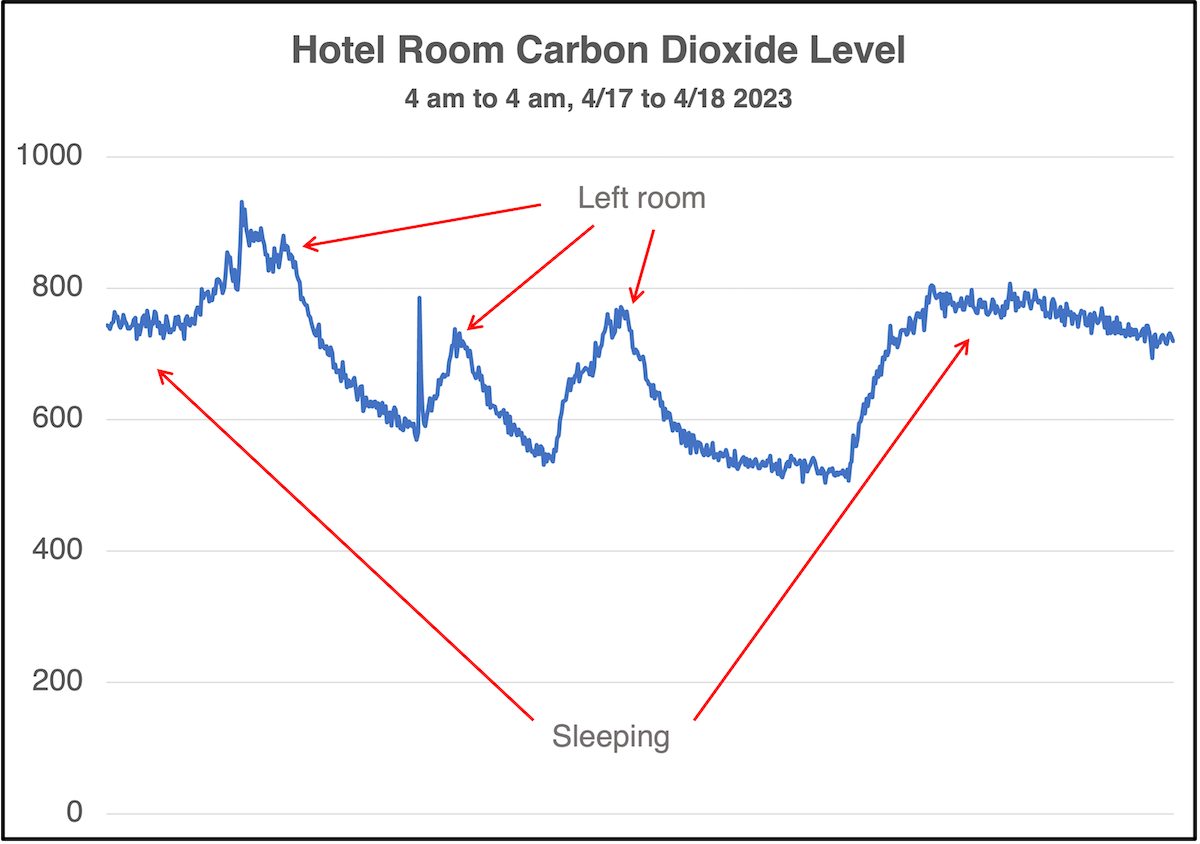
I’ve annotated the graph with the three times I left the room and the two periods when I was sleeping. You can see the decay in CO2 level with time after I left. In fact, there are mathematical models you can use to convert that rate of decay into a ventilation rate. You also can see that the CO2 level started dropping a little while after I went to sleep. That’s most likely because of a lower metabolism, slower breathing, and thus less CO2 coming out of my lungs.
And a plumbing design bonus
Not related to ventilation, but the shower design was nice, too. You can see the controls on the left, at the entrance, and the showerhead on the right. (That’s not a window beneath the showerhead. It’s a reflection of the mirror in the glass shower wall.) The reason it’s a nice design touch is because you can turn on the shower without getting the initial blast of cold water in your face.
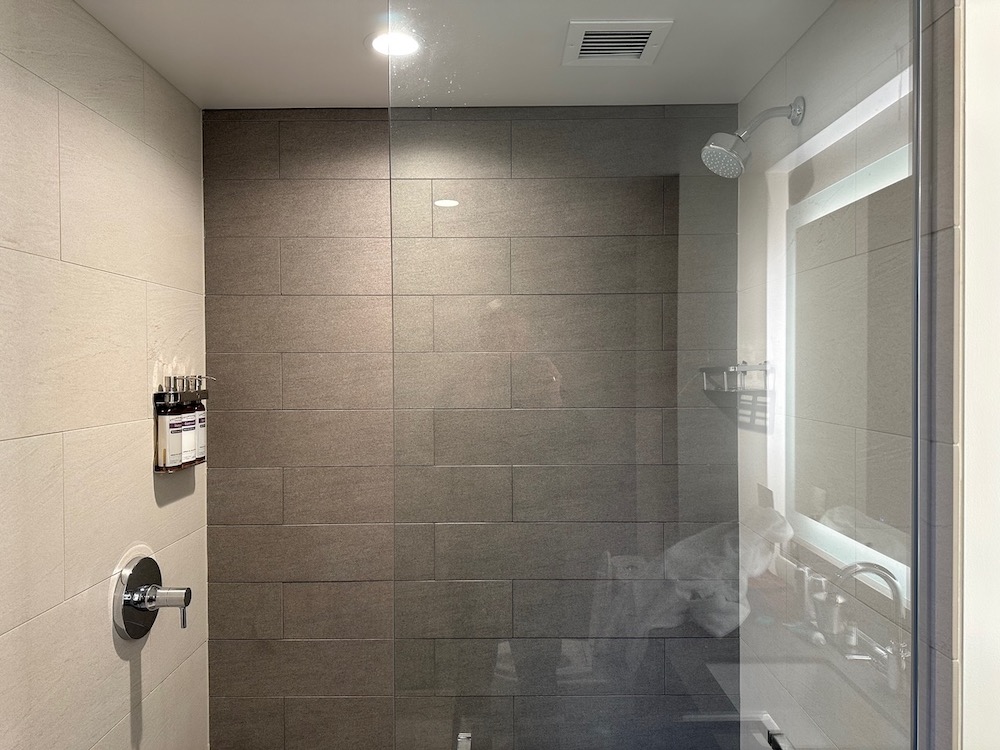
You can’t see it in this photo, but this shower had another nice touch, too: a linear drain.
The sum and substance
Ventilation is important. Having a supply and exhaust ventilation system is ideal. When the supply air comes from a known location where it brings in the best possible air from around the building, it’s even better. I don’t know where the supply air was coming from in this hotel, but I think I’d have noticed if it was coming from the street level, or worse, the parking deck.
And the absolute best would be to have a balanced ventilation system (equal supply and exhaust) with recovery of heat and, in most places, moisture. Still, I’m really happy to have had both supply and exhaust ventilation in my room at the Seattle Hyatt Regency. Kudos to them for doing it right!
Allison A. Bailes III, PhD is a speaker, writer, building science consultant, and the founder of Energy Vanguard in Decatur, Georgia. He has a doctorate in physics and is the author of a popular book on building science. He also writes the Energy Vanguard Blog. You can follow him on Twitter at @EnergyVanguard.
* This is an Amazon Associate link. You pay the same price you would pay normally, but Energy Vanguard may make a small commission if you buy after using the link.
Related Articles
Adventures in Hotel Bathroom Ventilation
What a Carbon Dioxide Monitor Tells You
Why You Probably Need an ERV, Not an HRV
Comments are moderated. Your comment will not appear below until approved.
This Post Has 20 Comments
Comments are closed.

Hotels often have Make Up Air units for intake air that dumps into the hallways, the question becomes how often do they actually work right 🤔
Dedicated intake for each room is impressive, don’t see that often. No “value engineering” going on here 😎
Bob: Yeah, dumping makeup air in the hall would have been a problem here because the door was pretty airtight.
I stayed in an identical room at the conference and noticed the same thing, but I had one big complaint: There’s no door on the shower and the vent pulls COLD air across the side of your wet body that’s facing the opening! There was definitely a cold draft! 🙂
Russ: Yeah, I noticed that, too, but I was surprised that the floor didn’t get wetter than it did.
My first guess on what that grill into the room would have been… “That’s where they’re dumping the exhaust from the bathroom!” Thanks for confirming that’s not what they did… and for restoring my faith in the wisdom of the Human Species.
Rick: Well, I hadn’t thought of that possibility. Hmmm. I’m pretty sure I’d have noticed if that were the case because the humidity in the room would have stayed higher.
Nice testing. Unfortunately, the graph is telling us nothing about your dreams, other than that they were up and down.
This hotel made an effort to be truly hospitable and comfortable to its guests, other than smiles and polite greetings. Why couldn’t our homes be like that?
Paul: I was dreaming about skiing down a beautiful slope that doesn’t exist. It’s the most magical ski slope in the world, and I visit it as often as I can. That’s the up-and-downness you’re seeing in the graph.
The arrangement of the controls and shower head makes so much sense so I don’t understand why everyone doesn’t do that. Does it really cost that much more to run a single pipe from the valve to the head that much further?
It appears that there is no door on that “walk-in” shower. I have seen that more often lately in hotels and homes. It seems dumb to me. Not having a door means that the rest of the bathroom fogs up faster and it is much cooler in the shower which is uncomfortable to me. I know this because my latest house originally had a walk-in shower with no door and I had one installed shortly after we moved in. It was a great improvement in terms of keeping humidity down in the rest of the bathroom and having a more comfortable environment in the shower.
I read somewhere that it is a code requirement to be able to turn on a shower without getting wet. I haven’t confirmed that, but it would make sense that if you had scalding water (which you shouldn’t by code either although the Dallas Omni certainly did) you wouldn’t want to have to be scalded to adjust the temperature.
RoyC: Yeah, that seems to be a trend in some hotels these days. Fortunately, it was big enough that not much water splashed out.
My comment was not about liquid water spraying out of the shower when there is no door. I am talking about the big natural convection currents that occur between the shower stall and the rest of the bathroom that causes the humidity to rise much faster in the rest of the bathroom and the shower stall being cooler when there is no door. A door greatly reduces that convection even if it doesn’t go all of the way to the ceiling.
Roy: Yeah, I guess I didn’t do a good transition there. I was just adding a bit about the secondary issue.
Toilet paper!!! Why didn’t I think of that, got a sheet, a grab stick and voila I have confirmation. Of course, my dirty filters are proof, and same fan powers in and out.
I have 10 foot ceilings, and had to climb a ladder to feel the input air. I remembered the “tell tales” that sailors use to monitor sail trim, and got a couple of short bits of light wool and taped them by the vents, and now I can tell at a glance.
Took the wife several weeks to notice then she thought they were cobwebs. Wonder how long it will take to notice the tp. Good thing she is tolerant of my “research”.
John: Why the permanent installation? Is your fan so quiet that you’re going to use that as a visual indicator of fan operation?
According to graph you have a sleep apnea 😛
Cold blasts are why I always install a toe tester in a shower. That and having somewhere to fill a bucket. Not keen on open showers because of the cold drafts and I certainly don’t want to be out of the spray when adjusting the temperature.
Nice that they have balanced air. 🙂
I wonder how common it is for hotel ventilation to be filtered. For homes, I found that inline MERV15 filter assemblies with low pressure loss (~.02 in w.g.) are relatively inexpensive. I plan to install one in the intake line of my HRV system. My system is between 150 and 200 cfm for the house which is 3000 square feet. That would be about 15 rooms in a hotel. The relatively new Hyatt Regency in Seattle has nearly 1,500 rooms on 45 floors so would need at least 100x the filter area we would. Looking into this a bit, it seems that most hotels do not filter the air as a matter of course as evidenced by ones that are starting to do it on a room-by-room basis. In my former start up focused on lighting that supports circadian rhythm, we found that capital improvement money is hard to find for what are viewed as amenities whose competition is doing nothing. You mention monitoring CO2, Allison. It would be interesting to check indoor air quality.
Commercial filters are typically MERV 8 for cost reasons. Keep in mind facilities are often buying multiple boxes of them at a time. MERV 11 or higher is a special order. The bigger issue is making sure they are changed regularly, not just when they are so bad it causes equipment failure.
Wow…. So how accurate is a uHoo air quality monitor? Right now I’m sitting at around 1800ppm with 2 windows open about 1/2″ each.
I’m thinking I need a ventilating dehumidifier and run my own duct for it. HVAC is in the attic and I don’t even like that but I have no choice right now.